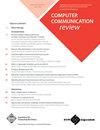Assessment of Left Ventricular Functions in Hypertensive Diabetic Patients by Speckle Tracking Imaging: Correlation with Brain Natriuretic Peptide Levels
IF 2.2
4区 计算机科学
Q3 COMPUTER SCIENCE, INFORMATION SYSTEMS
引用次数: 0
Abstract
Background: Hypertension and diabetes are major contributors to structural changes including myocardial fibrosis and progressive alteration of LV systolic and diastolic functions. Two-dimensional speckle tracking echocardiography is a reliable imaging modality that overcomes the limitations of Tissue Doppler imaging and allows a more accurate assessment of myocardial deformation at the global and regional levels. Objectives: The investigation aims to assess Left Ventricular functions in patients with hypertension and/or diabetes who have apparently preserved LV systolic function; using speckle tracking echocardiography, and correlate the findings with plasma Brain Natriuretic Peptide levels. Methods: Twenty healthy subjects were enrolled as a control group. Sixty patients with hypertension and/or diabetes were recruited and assembled as three equal groups, hypertensives, diabetics, and hypertensive-diabetics. 2D-STE was performed to assess LV longitudinal strain and strain rate. Plasma BNP levels were measured for all subjects. Results: Global systolic longitudinal strain was significantly reduced in patients compared to controls (P=0.001). It was more reduced in group 4. Global systolic SR was reduced in patients compared to controls, being more significantly reduced in groups 2 and 4 (P=0.001). Global early diastolic SR was reduced in patients compared to controls (P=0.001). Meanwhile, Global late diastolic SR values were higher among patients, especially groups 2 and 4 (P=0.001). BNP levels were significantly higher in group 4 compared to group 1 (P=0.000), group 2 (P=0.000), and group 3 (P=0.000). BNP levels and global systolic strain in group 4 were significantly correlated. Conclusion: LV systolic dysfunction was found among all patients groups, confirmed by the significant reduction in LV global longitudinal systolic SR. Hypertensive-diabetics exhibited lower global strain than patients with hypertension only and patients with diabetes only, even though their EF showed no apparent difference. Elevated BNP levels, being the highest among group 4, indicate the presence of ventricular dysfunction, even before chamber failure occurs.斑点追踪成像评价高血压糖尿病患者左心室功能与脑钠肽水平的相关性
背景:高血压和糖尿病是导致结构变化的主要因素,包括心肌纤维化和左心室收缩和舒张功能的进行性改变。二维斑点跟踪超声心动图是一种可靠的成像模式,它克服了组织多普勒成像的局限性,并允许在全局和区域水平上更准确地评估心肌变形。目的:本研究旨在评估明显保留左心室收缩功能的高血压和/或糖尿病患者的左心室功能;使用斑点跟踪超声心动图,并将结果与血浆脑钠肽水平相关联。方法:选择20名健康受试者作为对照组。招募了60名高血压和/或糖尿病患者,并将其分为三组,即高血压患者、糖尿病患者和高血压糖尿病患者。2D-STE用于评估左心室纵向应变和应变速率。测量所有受试者的血浆BNP水平。结果:与对照组相比,患者的整体收缩纵向应变显著降低(P=0.001)。第4组的总体收缩纵向应变降低幅度更大。与对照组相比,患者的整体收缩SR降低,第2组和第4组的降低更为显著(P=0.001)。与对照组比较,患者的总体舒张早期SR降低(P=0.001,第2组(P=0.000)和第3组(P=0.0000)。第4组的BNP水平与整体收缩应变显著相关。结论:在所有患者组中都发现了左心室收缩功能障碍,左心室整体纵向收缩SR显著降低证实了这一点。高血压糖尿病患者的整体应变低于仅高血压患者和仅糖尿病患者,尽管他们的EF没有显着差异。BNP水平升高,在第4组中最高,表明存在心室功能障碍,甚至在心室衰竭发生之前。
本文章由计算机程序翻译,如有差异,请以英文原文为准。
求助全文
约1分钟内获得全文
求助全文
来源期刊

ACM Sigcomm Computer Communication Review
工程技术-计算机:信息系统
CiteScore
6.90
自引率
3.60%
发文量
20
审稿时长
4-8 weeks
期刊介绍:
Computer Communication Review (CCR) is an online publication of the ACM Special Interest Group on Data Communication (SIGCOMM) and publishes articles on topics within the SIG''s field of interest. Technical papers accepted to CCR typically report on practical advances or the practical applications of theoretical advances. CCR serves as a forum for interesting and novel ideas at an early stage in their development. The focus is on timely dissemination of new ideas that may help trigger additional investigations. While the innovation and timeliness are the major criteria for its acceptance, technical robustness and readability will also be considered in the review process. We particularly encourage papers with early evaluation or feasibility studies.
 求助内容:
求助内容: 应助结果提醒方式:
应助结果提醒方式:


